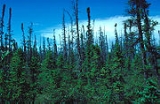
Birds of North American boreal forests
Encyclopedia
The boreal forest or taiga
of the North American continent stretches through a majority of Canada
and most of central Alaska
, extending spottily into the beginning of the Rocky Mountain range in Northern Montana
and into New England
and the Adirondack Mountains of New York
. This habitat extends as far North as the tree line (replaced by the High Arctic tundra
) and discontinues in mixed deciduous-coniferous forests to the south. The "taiga
", as it is called there, of Eurasia
occupies a similar range on those continents. Throughout the Northern Hemisphere, the boreal forest covers 2.3 million square miles, a larger area than the remaining Brazil
ian Amazon rain forest. Although it is largely forest, the boreal forests include a network of lake
s, river
valleys, wetland
s, peat
lands and semi-open tundra
.
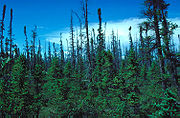 Only 8% of the Canadian boreal forest is protected and over 30% has already been designated for logging, energy and other development, much of it within the last decade. The U.S. is the leading importer of Canadian wood products as well as oil and gas, having purchased 20 billion dollars (approximately 80% of Canada's timber exports) worth of Canadian forest products in 2001. Presently trees being logged in the Boreal are primarily pulped and turned into disposable products such as toilet tissue, junk mail, and catalogs. Decisions will be made in the next several years regarding the remaining lands and where development will take place.
Only 8% of the Canadian boreal forest is protected and over 30% has already been designated for logging, energy and other development, much of it within the last decade. The U.S. is the leading importer of Canadian wood products as well as oil and gas, having purchased 20 billion dollars (approximately 80% of Canada's timber exports) worth of Canadian forest products in 2001. Presently trees being logged in the Boreal are primarily pulped and turned into disposable products such as toilet tissue, junk mail, and catalogs. Decisions will be made in the next several years regarding the remaining lands and where development will take place.
Historically, this wilderness has long remained vast and little-known to birding and naturalist groups, who have placed their attentions southwards. Although, the wintering grounds of many North American migratory birds also requires attention, now it has become apparent that our attention must be focused north on the Boreal breeding grounds of many of these birds. It is estimated that about 60% of the American bird population found North of the Mexican
border nests in the boreal forest. About half of North America's breeding species (over 300) make their home there. The following is a list of the North American birds reliant on the boreal forests.
.jpg)
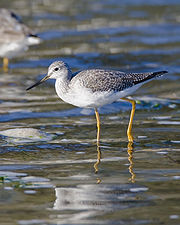


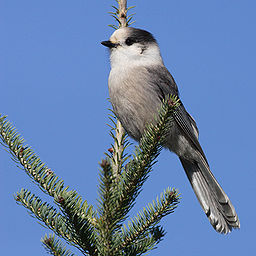
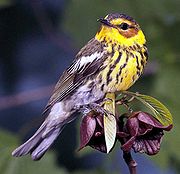
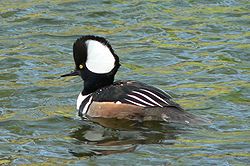
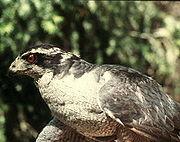

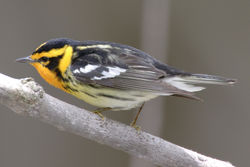
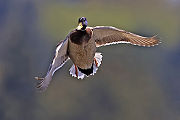
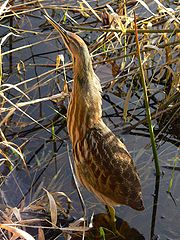

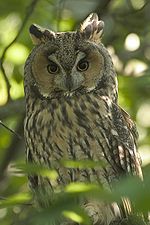
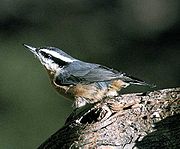

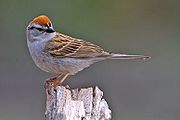
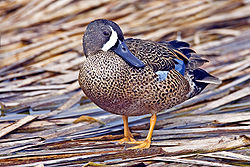

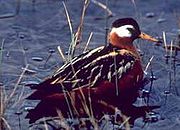

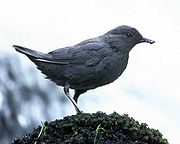
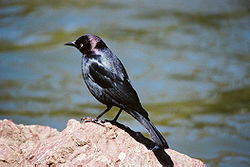
Taiga
Taiga , also known as the boreal forest, is a biome characterized by coniferous forests.Taiga is the world's largest terrestrial biome. In North America it covers most of inland Canada and Alaska as well as parts of the extreme northern continental United States and is known as the Northwoods...
of the North American continent stretches through a majority of Canada
Canada
Canada is a North American country consisting of ten provinces and three territories. Located in the northern part of the continent, it extends from the Atlantic Ocean in the east to the Pacific Ocean in the west, and northward into the Arctic Ocean...
and most of central Alaska
Alaska
Alaska is the largest state in the United States by area. It is situated in the northwest extremity of the North American continent, with Canada to the east, the Arctic Ocean to the north, and the Pacific Ocean to the west and south, with Russia further west across the Bering Strait...
, extending spottily into the beginning of the Rocky Mountain range in Northern Montana
Montana
Montana is a state in the Western United States. The western third of Montana contains numerous mountain ranges. Smaller, "island ranges" are found in the central third of the state, for a total of 77 named ranges of the Rocky Mountains. This geographical fact is reflected in the state's name,...
and into New England
New England
New England is a region in the northeastern corner of the United States consisting of the six states of Maine, New Hampshire, Vermont, Massachusetts, Rhode Island, and Connecticut...
and the Adirondack Mountains of New York
New York
New York is a state in the Northeastern region of the United States. It is the nation's third most populous state. New York is bordered by New Jersey and Pennsylvania to the south, and by Connecticut, Massachusetts and Vermont to the east...
. This habitat extends as far North as the tree line (replaced by the High Arctic tundra
Tundra
In physical geography, tundra is a biome where the tree growth is hindered by low temperatures and short growing seasons. The term tundra comes through Russian тундра from the Kildin Sami word tūndâr "uplands," "treeless mountain tract." There are three types of tundra: Arctic tundra, alpine...
) and discontinues in mixed deciduous-coniferous forests to the south. The "taiga
Taiga
Taiga , also known as the boreal forest, is a biome characterized by coniferous forests.Taiga is the world's largest terrestrial biome. In North America it covers most of inland Canada and Alaska as well as parts of the extreme northern continental United States and is known as the Northwoods...
", as it is called there, of Eurasia
Eurasia
Eurasia is a continent or supercontinent comprising the traditional continents of Europe and Asia ; covering about 52,990,000 km2 or about 10.6% of the Earth's surface located primarily in the eastern and northern hemispheres...
occupies a similar range on those continents. Throughout the Northern Hemisphere, the boreal forest covers 2.3 million square miles, a larger area than the remaining Brazil
Brazil
Brazil , officially the Federative Republic of Brazil , is the largest country in South America. It is the world's fifth largest country, both by geographical area and by population with over 192 million people...
ian Amazon rain forest. Although it is largely forest, the boreal forests include a network of lake
Lake
A lake is a body of relatively still fresh or salt water of considerable size, localized in a basin, that is surrounded by land. Lakes are inland and not part of the ocean and therefore are distinct from lagoons, and are larger and deeper than ponds. Lakes can be contrasted with rivers or streams,...
s, river
River
A river is a natural watercourse, usually freshwater, flowing towards an ocean, a lake, a sea, or another river. In a few cases, a river simply flows into the ground or dries up completely before reaching another body of water. Small rivers may also be called by several other names, including...
valleys, wetland
Wetland
A wetland is an area of land whose soil is saturated with water either permanently or seasonally. Wetlands are categorised by their characteristic vegetation, which is adapted to these unique soil conditions....
s, peat
Peat
Peat is an accumulation of partially decayed vegetation matter or histosol. Peat forms in wetland bogs, moors, muskegs, pocosins, mires, and peat swamp forests. Peat is harvested as an important source of fuel in certain parts of the world...
lands and semi-open tundra
Tundra
In physical geography, tundra is a biome where the tree growth is hindered by low temperatures and short growing seasons. The term tundra comes through Russian тундра from the Kildin Sami word tūndâr "uplands," "treeless mountain tract." There are three types of tundra: Arctic tundra, alpine...
.

Historically, this wilderness has long remained vast and little-known to birding and naturalist groups, who have placed their attentions southwards. Although, the wintering grounds of many North American migratory birds also requires attention, now it has become apparent that our attention must be focused north on the Boreal breeding grounds of many of these birds. It is estimated that about 60% of the American bird population found North of the Mexican
Mexico
The United Mexican States , commonly known as Mexico , is a federal constitutional republic in North America. It is bordered on the north by the United States; on the south and west by the Pacific Ocean; on the southeast by Guatemala, Belize, and the Caribbean Sea; and on the east by the Gulf of...
border nests in the boreal forest. About half of North America's breeding species (over 300) make their home there. The following is a list of the North American birds reliant on the boreal forests.
Birds almost totally dependent on the boreal forests
The following is a list (taxonomically organized) of the breeding species of which at least 70% of their North American population reply upon the boreal forest for nesting. If the boreal forests were cleared, these species would almost surely perish or be endangered..jpg)
- Surf ScoterSurf ScoterThe Surf Scoter is a large sea duck, which breeds in Canada and Alaska. It is placed in the subgenus Melanitta, along with the Velvet and White-winged Scoters, distinct from the subgenus Oidemia, Black and Common Scoters.It winters further south in temperate zones, on the coasts of the northern USA...
, Melanitta perspicillata - White-winged ScoterWhite-winged ScoterThe White-winged Scoter is a large sea duck.-Description:It is characterised by its bulky shape and large bill. This is the largest species of scoter. Females range from 950-1950 grams and 48–56 cm , averaging 1180 grams and 52.3 cm . She is brown with pale head patches...
, Melanitta fusca - Black ScoterBlack ScoterThe Black or American Scoter is a large sea duck, 43 to 49 centimeters in length. Together with the Common Scoter M. nigra, it forms the subgenus Oidemia; the two are sometimes considered conspecific, the Black Scoter then being referred to as M. nigra americana...
, Melanitta nigra - BuffleheadBuffleheadThe Bufflehead is a small American sea duck of the genus Bucephala, the goldeneyes. This species was first described by Linnaeus in his Systema naturae in 1758 as Anas albeola.-Description:...
, Bucephala albeola - Common GoldeneyeCommon GoldeneyeThe Common Goldeneye is a medium-sized sea duck of the genus Bucephala, the goldeneyes. Their closest relative is the similar Barrow's Goldeneye....
, Bucephala clangula - Spruce GrouseSpruce GrouseThe Spruce Grouse or Canada Grouse is a medium-sized grouse closely associated with the coniferous boreal forests or taiga of North America. It is one of the most arboreal grouse, fairly well adapted to perching and moving about in trees...
, Dendragapus canadensis - Common Loon, Gavia immer
- Horned Grebe, Podiceps auritus
- Red-necked GrebeRed-necked GrebeThe Red-necked Grebe is a migratory aquatic bird found in the temperate regions of the northern hemisphere. Its wintering habitat is largely restricted to calm waters just beyond the waves around ocean coasts, although some birds may winter on large lakes...
, Podiceps grisegena - Whooping CraneWhooping CraneThe whooping crane , the tallest North American bird, is an endangered crane species named for its whooping sound. Along with the Sandhill Crane, it is one of only two crane species found in North America. The whooping crane's lifespan is estimated to be 22 to 24 years in the wild...
, Grus americana - Greater YellowlegsGreater YellowlegsThe Greater Yellowlegs, Tringa melanoleuca, is a large North American shorebird, similar in appearance to the smaller Lesser Yellowlegs. Its closest relative, however, is the Greenshank, which together with the Spotted Redshank form a close-knit group...
, Tringa melanoleuca

- Lesser YellowlegsLesser YellowlegsThe Lesser Yellowlegs is a medium-sized shorebird similar in appearance to the larger Greater Yellowlegs. It is not closely related to this bird, however, but instead to the much larger and quite dissimilar Willet; merely the fine, clear and dense pattern of the neck shown in breeding plumage...
, Tringa flavipes - Solitary SandpiperSolitary SandpiperThe Solitary Sandpiper is a small wader .-Description:This species measures long, with a wingspan up to and a body mass of . It is a dumpy wader with a dark green back, greyish head and breast and otherwise white underparts. It is obvious in flight, with wings dark above and below, and a dark...
, Tringa solitaria - Wandering TattlerWandering TattlerThe Wandering Tattler, Tringa incana , is a medium-sized wading bird. It is similar in appearance to the closely related Gray-tailed Tattler, T. brevipes...
, Heteroscelus incanus - Spotted SandpiperSpotted SandpiperThe Spotted Sandpiper is a small shorebird, 18–20 cm long. Together with its sister species, the Common Sandpiper they make up the genus Actitis...
, Actitis macularius - WhimbrelWhimbrelThe Whimbrel Numenius phaeopus, is a wader in the large family Scolopacidae. It is one of the mostwidespread of the curlews, breeding across much of subarctic North America, Europe and Asia as far south as Scotland....
, Numenius phaeopus - SurfbirdSurfbirdThe Surfbird is a small stocky wader in the family Scolopacidae. It is usually classified in a genus of its own, as Aphriza virgata, and was once considered to be allied to the turnstones, but more recent data suggests it is very close genetically to the Red and Great Knots and should be included...
, Aphriza virgata - Short-billed DowitcherShort-billed DowitcherThe Short-billed Dowitcher like its congener the Long-billed Dowitcher, is a medium-sized, stocky, long-billed shorebird in the family Scolopacidae. It is an inhabitant of North America, Middle America, and northern South America. It is strongly migratory; it completely vacates in breeding areas...
Limnodromus griseus - Common Black-headed Gull, Larus ridibundus

- Bonaparte's GullBonaparte's GullThe Bonaparte's Gull is a small gull.The Bonaparte's Gull is a small species, larger only than the Little Gull and the Saunders's Gull among all gull species. Adults are long with a wingspan and a body mass of . They have a black hood and a short thin dark bill. The body is mainly white with...
, Larus philadelphia - Herring Gull, Larus argentatus
- Great Black-backed GullGreat Black-backed GullThe Great Black-backed Gull is the largest gull in the world, which breeds on the European and North American coasts and islands of the North Atlantic...
, Larus marinus - Common TernCommon TernThe Common Tern is a seabird of the tern family Sternidae. This bird has a circumpolar distribution, breeding in temperate and sub-Arctic regions of Europe, Asia and east and central North America. It is strongly migratory, wintering in coastal tropical and subtropical regions. It is sometimes...
, Sterna hirundo - Northern Hawk OwlNorthern Hawk OwlThe Northern Hawk-Owl is a non-migratory owl that usually stays within its breeding range. It sometimes irrupts southward.-General:It is the only living species in the genus Surnia...
, Surnia ulula - Great Gray Owl, Strix nebulosa
- Boreal Owl, Aegolius funereus
- American Three-toed WoodpeckerAmerican Three-toed WoodpeckerThe American Three-toed woodpecker, Picoides dorsalis is a medium-sized woodpecker .This woodpecker has a length of 21 cm and a wingspan of 38 cm and closely resembles the Black-backed Woodpecker, which is also three-toed. Until recently, it was considered to be the same species as the Eurasian...
, Picoides dorsalis - Black-backed WoodpeckerBlack-backed WoodpeckerThe Black-backed Woodpecker also known as the Arctic Three-toed Woodpecker is a medium-sized woodpecker inhabiting the forests of North America. It is a medium sized woodpecker ....
, Picoides arcticus

- Yellow-bellied FlycatcherYellow-bellied FlycatcherThe Yellow-bellied Flycatcher is a small insect-eating bird of the tyrant flycatcher family.Adults have brownish-olive upperparts, darker on the wings and tail, with yellowish underparts; they have a white eye ring, white wing bars, a small bill and a short tail...
, Empidonax flaviventris - Alder FlycatcherAlder FlycatcherThe Alder Flycatcher, Empidonax alnorum, is a small insect-eating bird of the tyrant flycatcher family.Adults have olive-brown upperparts, browner on the wings and tail, with whitish underparts; they have a white eye ring, white wing bars, a small bill and a short tail. The breast is washed with...
, Empidonax alnorum - Northern Shrike, Lanius excubitor
- Philadelphia VireoPhiladelphia VireoThe Philadelphia Vireo, Vireo philadelphicus, is a small songbird.Adults are mainly olive-brown on the upperparts with yellow underparts; they have dark eyes and a grey crown. There is a dark line through the eyes and a white stripe just over them. They have thick blue-grey legs and a stout...
, Vireo philadelphicus - Gray JayGray JayThe Gray Jay , also Grey Jay, Canada Jay, or Whiskey Jack, is a member of the crow and jay family found in the boreal forests across North America north to the tree-line and in subalpine forests of the Rocky Mountains south to New Mexico and Arizona...
, Perisoreus canadensis - Boreal ChickadeeBoreal ChickadeeThe Boreal Chickadee is a small passerine bird in the tit family Paridae.-Description:...
, Poecile hudsonica - Ruby-crowned Kinglet, Regulus calendula
- Gray-cheeked ThrushGray-cheeked ThrushThe Grey-cheeked Thrush, Catharus minimus, is a medium-sized thrush. This species is 15–17 cm in length, and has the white-dark-white underwing pattern characteristic of Catharus thrushes. It is a member of a close-knit group of migrant species together with the Veery and Bicknell's Thrush ;...
, Catharus minimus - Bicknell's ThrushBicknell's ThrushThe Bicknell's Thrush, Catharus bicknelli, is a medium-sized thrush, at 17.5 cm and 28 g . It was named after Eugene Bicknell, an American amateur ornithologist, who discovered the species on Slide Mountain in the Catskills in the late 19th century.Adults are olive-brown on the upperparts,...
, Catharus bicknelli - Swainson's ThrushSwainson's ThrushSwainson's Thrush , also called Olive-backed Thrush, is a medium-sized thrush. This species is 16–18 cm in length, and has the white-dark-white underwing pattern characteristic of Catharus thrushes...
, Catharus ustulatus - Hermit ThrushHermit ThrushThe Hermit Thrush is a medium-sized North American thrush. It is not very closely related to the other North American migrant species of Catharus, but rather to the Mexican Russet Nightingale-thrush.-Description:...
, Catharus guttatus

- Bohemian WaxwingBohemian WaxwingThe Bohemian Waxwing is a member of the waxwing family of passerines. A sleek bird, 18–21 cm long with a pointed crest, it travels in large, nomadic groups with a strong, direct flight. It breeds in coniferous forests throughout the most northern parts of Europe, Asia and western North America...
, Bombycilla garrulus - Tennessee WarblerTennessee WarblerThe Tennessee Warbler, Oreothlypis peregrina, is a New World warbler. It breeds in northern North America across Canada and the northern USA. It is migratory, wintering in southern Central America and northern Colombia and Venezuela, with a few stragglers going as far south as Ecuador. It is a...
, Vermivora peregrina - Magnolia WarblerMagnolia WarblerSetophaga magnolia, commonly known as the Magnolia warbler, is a member of the Parulidae family of wood warblers. [4] This warbler was first discovered in magnolia trees in the 19th century by famed ornithologist Alexander Wilson while in Mississippi. [7]-Description:The magnolia warbler can be...
, Dendroica magnolia - Cape May WarblerCape May WarblerThe Cape May Warbler, Dendroica tigrina, is a small New World warbler. It breeds in northern North America. Its breeding habitat spans across all but the westernmost parts of southern Canada, and into the Great Lakes region and New England. It is migratory, wintering in the West Indies...
, Dendroica tigrina - Yellow-rumped WarblerYellow-rumped WarblerFour closely related North American bird forms—the eastern Myrtle Warbler , its western counterpart, Audubon's Warbler , the northwest Mexican Black-fronted Warbler , and the Guatemalan Goldman's Warbler —are periodically lumped as the Yellow-rumped Warbler .-Classification:Since...
, Dendroica coronata - Kirtland's WarblerKirtland's WarblerKirtland's Warbler is a small songbird of the New World warbler family , named after Jared P. Kirtland, an Ohio doctor and amateur naturalist. Nearly extinct just 50 years ago, it is well on its way to recovery. It requires large areas of dense young jack pine for its breeding habitat...
, Dendroica kirtlandii - Palm WarblerPalm WarblerThe Palm Warbler, Dendroica palmarum, is a small songbird of the New World warbler family.The species comprises two distinct subspecies that may merit specific status....
, Dendroica palmarum - Bay-breasted WarblerBay-breasted WarblerThe Bay-breasted Warbler, Dendroica castanea , is a New World warbler. They breed in northern North America, specifically in Canada, into the Great Lakes region, and into northern New England....
, Dendroica castanea - Blackpoll WarblerBlackpoll WarblerThe Blackpoll Warbler, Dendroica striata , is a New World warbler. Breeding males are mostly black and white. They have a prominent black cap, white cheeks and white wing bars. The Blackpoll breeds in northern North America, from Alaska, through most of Canada, and into the Great Lakes region and...
, Dendroica striata - Northern WaterthrushNorthern WaterthrushThe Northern Waterthrush is one of the larger New World warblers. It breeds in the northern part of North America in Canada, and in the northern United States, . This bird is migratory, wintering in Central America, the West Indies, and Florida; also Venezuela, Colombia, and Ecuador...
, Seiurus noveboracensis - Connecticut WarblerConnecticut WarblerThe Connecticut Warbler Oporornis agilis is a small songbird of the New World warbler family.These 15 cm long birds have light yellow underparts and olive upperparts; they have a light eye ring, pink legs, a long tail, pale wing bars and a thin pointed bill...
, Oporornis agilis - Mourning WarblerMourning WarblerThe Mourning Warbler, Oporornis philadelphia, is a small songbird of the New World warbler family.These 13 cm long birds have yellow underparts, olive-green upperparts and pink legs. Adult males have a grey hood and a black patch on the throat and breast...
, Oporornis philadelphia

- Le Conte's SparrowLe Conte's SparrowThe Le Conte’s Sparrow, Ammodramus leconteii, is one of the smallest sparrow species in North America.It is a very secretive bird that prefers to spend most of its time on the ground under the cover of tall grasses. They are typically very difficult to flush, often only flushing at a distance of...
, Ammodramus leconteii - Lincoln's SparrowLincoln's SparrowThe Lincoln's Sparrow, Melospiza lincolnii, is a medium-sized sparrow.Adults have dark-streaked olive-brown upperparts with a light brown breast with fine streaks, a white belly, and a white throat. They have a brown cap with a grey stripe in the middle, olive-brown wings, and a narrow tail. Their...
, Melospiza lincolnii - Swamp SparrowSwamp SparrowThe Swamp Sparrow is a medium-sized sparrow related to the Song Sparrow.Adults have streaked rusty, buff and black upperparts with a gray breast, light belly and a white throat. The wings are strikingly rusty. Most males and a few females have a rust-colored caps. Their face is gray with a dark...
, Melospiza georgiana - White-throated SparrowWhite-throated SparrowThe White-throated Sparrow is a passerine bird of the American sparrow family Emberizidae.-Description:The White-throated Sparrow is a passerine bird of the American sparrow family Emberizidae...
, Zonotrichia albicollis - Dark-eyed JuncoDark-eyed JuncoThe Dark-eyed Junco is the best-known species of the juncos, a genus of small grayish American sparrows. This bird is common across much of temperate North America and in summer ranges far into the Arctic...
, Junco hyemalis - Rusty BlackbirdRusty BlackbirdThe Rusty Blackbird, Euphagus carolinus, is a medium-sized blackbird, closely related to grackles .-Appearance:...
, Euphagus carolinus - Pine GrosbeakPine Grosbeakleft|thumb|Adult femaleThe Pine Grosbeak is a large member of the true finch family, Fringillidae. It is found in coniferous woods across Alaska, the western mountains of the United States, Canada, and in subarctic Fennoscandia and Siberia...
, Pinicola enucleator - Red Crossbill, Loxia curvirostra
- White-winged Crossbill, Loxia leucoptera
- Common RedpollCommon RedpollThe Common Redpoll is a species in the finch family. It breeds somewhat further south than the Arctic Redpoll, also in habitats with thickets or shrubs. Nominate C. f. flammea breeds across the northern parts of North America and Eurasia. There is also an Icelandic subspecies, Icelandic Redpoll...
, Carduelis flammea
Birds that are very dependent on the boreal forests
These are birds that more than half of the North American populations nest in the boreal forest. Many of these birds need mature forests or isolated, non-populated wetlands that now have been largely cleared outside of the boreal forests.
- Trumpeter SwanTrumpeter SwanThe Trumpeter Swan, Cygnus buccinator, is the largest native North American bird, if measured in terms of weight and length, and is the largest living waterfowl species on earth. It is the North American counterpart of the European Whooper Swan.-Description:Males typically measure from and weigh...
, Cygnus buccinator - American WigeonAmerican WigeonThe American Wigeon, also American Widgeon or Baldpate, is a species of wigeon in the dabbling duck genus Anas. If this is split up, all wigeons will go into their old genus Mareca again...
, Anas americana - American Black DuckAmerican Black DuckThe American Black Duck is a large dabbling duck. American Black Ducks are similar to Mallards in size, and resemble the female Mallard in coloration, although the Black Duck's plumage is darker...
, Anas rubripes - Green-winged TealGreen-winged TealThe Green-winged Teal is a common and widespread duck that breeds in the northern areas of North America except on the Aleutian Islands. It was considered conspecific with the Common Teal The Green-winged Teal (Anas carolinensis) is a common and widespread duck that breeds in the northern areas of...
, Anas crecca - Ring-necked DuckRing-necked DuckThe Ring-necked Duck is a smaller diving duck from North America.The adult male is similar in color pattern to the Eurasian Tufted Duck, its relative. It has a grey bill with a white band, a shiny purple head, a white breast, yellow eyes and a dark grey back...
, Aythya collaris - Greater ScaupGreater ScaupThe Greater Scaup , just Scaup in Europe, or colloquially known as "Bluebill", for its bright blue bill, is small compared to other diving ducks, however it is larger than the closely related Lesser Scaup...
, Aythya marila - Lesser ScaupLesser ScaupThe Lesser Scaup is a small North American diving duck that migrates south as far as Central America in winter. It is colloquially known as the Little Bluebill or Broadbill because of its distinctive blue bill...
, Aythya affinis - Barrow's GoldeneyeBarrow's GoldeneyeBarrow's Goldeneye is a medium-sized sea duck of the genus Bucephala, the goldeneyes. This bird was named after Sir John Barrow....
, Bucephala islandica - Hooded MerganserHooded MerganserThe Hooded Merganser is a small duck and is the only member of the genus Lophodytes.Hooded Mergansers have a crest at the back of the head which can be expanded or contracted. In adult males, this crest has a large white patch, the head is black and the sides of the duck are reddish-brown...
, Lophodytes cucullatus - Common MerganserCommon MerganserThe Common Merganser or Goosander Mergus merganser is a large duck, of rivers and lakes of forested areas of Europe, northern and central Asia, and North America. It eats fish and nests in holes in trees...
, Mergus merganser

- Ruffed GrouseRuffed GrouseThe Ruffed Grouse is a medium-sized grouse occurring in forests from the Appalachian Mountains across Canada to Alaska. It is non-migratory.The Ruffed Grouse is frequently referred to as a "partridge"...
, Bonasa umbellus - White-tailed PtarmiganWhite-tailed PtarmiganThe White-tailed Ptarmigan, Lagopus leucura, is the smallest bird in the grouse family. It is found in the mountains of the western United States, Canada and Alaska.-Description:...
, Lagopus leucura - Pacific Loon, Gavia pacifica
- Northern Goshawk, Accipiter gentilis
- MerlinMerlin (bird)The Merlin is a small species of falcon from the Northern Hemisphere. A bird of prey once known colloquially as a pigeon hawk in North America, the Merlin breeds in the northern Holarctic; some migrate to subtropical and northern tropical regions in winter.-European and North American...
, Falco columbarius - Yellow RailYellow RailThe Yellow Rail, Coturnicops noveboracensis, is a small waterbird, of the family Rallidae.Adults have brown upperparts streaked with black, a yellowish-brown breast, a light belly and barred flanks. The short thick dark bill turns yellow in males during the breeding season. The feathers on the back...
, Coturnicops noveboracensis - SoraSora (crake)The Sora is a small waterbird of the family Rallidae, sometimes also referred to as the Sora Rail or Sora Crake.Adults Soras are long, with dark-marked brown upperparts, a blue-grey face and underparts, and black and white barring on the flanks. They have a short thick yellow bill, with black...
, Porzana carolina - Semipalmated PloverSemipalmated PloverThe Semipalmated Plover is a small plover.This species weighs and measures in length and across the wings. Adults have a grey-brown back and wings, a white belly, and a white breast with one black neckband...
, Charadrius semipalmatus - Hudsonian GodwitHudsonian GodwitThe Hudsonian Godwit, Limosa haemastica, is a large shorebird.-Identification:Adults have long dark legs and a long pink bill with a slight upward curve and dark at the tip. The upper parts are mottled brown and the underparts are chestnut. The tail is black and the rump is white...
, Limosa haemastica - Pectoral SandpiperPectoral SandpiperThe Pectoral Sandpiper, Calidris melanotos, is a small wader. It is sometimes separated with the "stint" sandpipers in Erolia. This may or may not represent a good monophyletic group, depending on the placement of the phylogenetically enigmatic Curlew Sandpiper , the type species of Erolia...
, Calidris melanotos - White-rumped SandpiperWhite-rumped SandpiperThe White-rumped Sandpiper is a small shorebird.Adults have black legs and a small thin dark bill. The body is dark brown on top and mainly white underneath, with brown streaks on the breast and a white rump. They have a white stripe over their eyes. This bird shows long wings in flight. In winter...
, Calidris fuscicollis - Least SandpiperLeast SandpiperThe Least Sandpiper is the smallest shorebird.This species has greenish legs and a short thin dark bill. Breeding adults are brown with dark brown streaks on top and white underneath. They have a light line above the eye and a dark crown. In winter, Least Sandpipers are grey above...
, Calidris minutilla - Common SnipeCommon SnipeThe Common Snipe is a small, stocky wader native to the Old World. The breeding habitat is marshes, bogs, tundra and wet meadows throughout northern Europe and northern Asia...
, Gallinago gallinago

- Red-necked PhalaropeRed-necked PhalaropeThe Red-necked Phalarope, Phalaropus lobatus, is a small wader. This phalarope breeds in the Arctic regions of North America and Eurasia. It is migratory, and, unusually for a wader, winters at sea on tropical oceans....
, Phalaropus lobatus - Mew GullCommon GullThe Common Gull or Mew Gull Larus canus is a medium-sized gull which breeds in northern Asia, northern Europe and northwestern North America. It migrates further south in winter...
, Larus canus - Ross's GullRoss's GullThe Ross's Gull is a small gull, the only species in its genus, although it has been suggested it should be moved to the genus Hydrocoloeus, which otherwise only includes the Little Gull....
, Rhodostethia rosea - Arctic TernArctic TernThe Arctic Tern is a seabird of the tern family Sternidae. This bird has a circumpolar breeding distribution covering the Arctic and sub-Arctic regions of Europe, Asia, and North America...
, Sterna paradisaea - Yellow-bellied SapsuckerYellow-bellied SapsuckerThe Yellow-bellied Sapsucker is a medium-sized woodpecker found in North America, Central America and the Caribbean.-Taxonomy:...
, Sphyrapicus varius - Olive-sided FlycatcherOlive-sided FlycatcherThe Olive-sided Flycatcher, Contopus cooperi, is a passerine bird. It is a medium-sized tyrant flycatcher.- Description :Adults are dark olive on the face, upperparts and flanks. They have light underparts, a large dark bill and a short tail....
, Contopus cooperi - Least FlycatcherLeast FlycatcherThe Least Flycatcher , , is a small insect-eating bird...
, Empidonax minimus - Blue-headed VireoBlue-headed VireoThe Blue-headed Vireo is a Neotropical migrating song bird found in North and Central America. There are currently two recognized sub-species that belong to the Blue-headed Vireo. It has a range that extends across Canada and the eastern coast of the United-States, Mexico and some of Central America...
, Vireo solitarius - Northern WheatearNorthern WheatearThe Northern Wheatear or Wheatear is a small passerine bird that was formerly classed as a member of the thrush family Turdidae, but is now more generally considered to be an Old World flycatcher, Muscicapidae...
, Oenanthe oenanthe - Orange-crowned WarblerOrange-crowned WarblerThe Orange-crowned Warbler is a small songbird of the New World warbler family.These birds are distinguished by their lack of wing bars, streaking on the underparts, strong face marking or bright colouring, resembling a fall Tennessee Warbler. The orange patch on the crown is usually not visible...
, Vermivora celata - Nashville WarblerNashville WarblerThe Nashville Warbler, Vermivora ruficapilla, is a small songbird in the New World warbler family.They have olive-brown upperparts, a white belly and a yellow throat and breast; they have a white eye ring, no wing bars and a thin pointed bill. Adult males have a grey head with a rusty crown patch ;...
, Vermivora ruficapilla - Chestnut-sided WarblerChestnut-sided WarblerThe Chestnut-sided Warbler is a New World warbler. They breed in eastern North America and in southern Canada westwards to the Canadian Prairies...
, Dendroica pensylvanica - Black-throated Green WarblerBlack-throated Green WarblerThe Black-throated Green Warbler, Setophaga virens, is a small songbird of the New World warbler family.It is 12 cm long and weighs 9 g, and has an olive-green crown, a yellow face with olive markings, a thin pointed bill, white wing bars, an olive-green back and pale underparts with...
, Dendroica virens

- Blackburnian WarblerBlackburnian WarblerThe Blackburnian Warbler, Dendroica fusca , is a small New World warbler. They breed in eastern North America, from southern Canada, westwards to the southern Canadian Prairies, the Great Lakes region and New England, to North Carolina....
, Dendroica fusca - Black-and-white WarblerBlack-and-white WarblerThe Black-and-white Warbler is a small New World warbler. It breeds in northern and eastern North America from southern Canada to Florida....
, Mniotilta varia - OvenbirdOvenbirdThe Ovenbird is a small songbird of the New World warbler family . This migratory bird breeds in eastern North America and moves south in winter.-Taxonomy:...
, Seiurus aurocapilla - Wilson's WarblerWilson's WarblerThe Wilson's Warbler, Wilsonia pusilla, is a small New World warbler. It is primarily greenish above and yellow below, with rounded wings and a long, slim tail. The male has a black crown patch which is greatly reduced or missing entirely in the female...
, Wilsonia pusilla - Canada WarblerCanada WarblerThe Canada Warbler is a small 13 cm long songbird of the New World warbler family.These birds have yellow underparts, blue-grey upperparts and pink legs; they also have yellow eye-rings and thin, pointed bills. Adult males have black foreheads and black necklaces...
, Wilsonia canadensis - Clay-colored SparrowClay-colored SparrowThe Clay-colored Sparrow is a small sparrow of North America.-Overview:Adults have light brown upperparts and pale underparts, with darker streaks on the back. They have a pale crown stripe on a dark brown crown, a white line over the eyes, a dark line through the eyes, a light brown cheek patch...
, Spizella pallida - American Tree SparrowAmerican Tree SparrowThe American Tree Sparrow , formerly known as the Winter Sparrow, is a medium-sized sparrow.Adults have a rusty cap and grey underparts with a small dark spot on the breast. They have a rusty back with lighter stripes, brown wings with white bars and a slim tail. Their face is grey with a rusty...
, Spizella arborea - Fox SparrowFox SparrowThe Fox Sparrow is a large American sparrow. It is the only member of the genus Passerella, although some authors split the genus into four species .-Taxonomy:...
Passerella iliaca - White-crowned SparrowWhite-crowned SparrowThe White-crowned Sparrow is a medium-sized sparrow native to North America.- Description :Adults are long and have black and white stripes on their head, a grey face, brown streaked upper parts and a long tail. The wings are brown with bars and the underparts are grey. Their bill is pink or yellow...
, Zonotrichia leucophrys - Golden-crowned SparrowGolden-crowned SparrowThe Golden-crowned Sparrow, Zonotrichia atricapilla, is a medium-sized sparrow. It is slightly larger than the closely related White-crowned Sparrow.-Description:...
, Zonotrichia atricapilla - Gray-crowned Rosy-Finch, Leucosticte tephrocotis
Birds that are partially dependent on the boreal forests
Although less than half of the following birds' North American populations nest in the boreal forests, a major portion of their species is reliant on this habitat. Many of these birds are more often aquatic and woodland generalist than species more dependent on the taiga.- Greater White-fronted Goose Anser albifrons
- Snow GooseSnow GooseThe Snow Goose , also known as the Blue Goose, is a North American species of goose. Its name derives from the typically white plumage. The genus of this bird is disputed...
Chen caerulescens - Canada GooseCanada GooseThe Canada Goose is a wild goose belonging to the genus Branta, which is native to arctic and temperate regions of North America, having a black head and neck, white patches on the face, and a brownish-gray body....
Branta canadensis

- MallardMallardThe Mallard , or Wild Duck , is a dabbling duck which breeds throughout the temperate and subtropical Americas, Europe, Asia, and North Africa, and has been introduced to New Zealand and Australia....
, Anas platyrhynchos - Northern ShovelerNorthern ShovelerThe Northern Shoveler , Northern Shoveller in British English, sometimes known simply as the Shoveler, is a common and widespread duck. It breeds in northern areas of Europe and Asia and across most of North America, and is a rare vagrant to Australia...
, Anas clypeata - Northern PintailNorthern PintailThe Pintail or Northern Pintail is a widely occurring duck which breeds in the northern areas of Europe, Asia and North America. It is strongly migratory and winters south of its breeding range to the equator...
, Anas acuta - CanvasbackCanvasbackThe Canvasback is the largest of the North American diving ducks, that ranges from between long and weighs approximately , with a wingspan of . The canvasback has a distinctive wedge-shaped head and long graceful neck. The adult male has a black bill, a chestnut red head and neck, a black...
, Aythya valisineria - Harlequin DuckHarlequin DuckThe Harlequin Duck is a small sea duck. It takes its name from Arlecchino, Harlequin in French, a colourfully dressed character in Commedia dell'arte. The species name comes from the Latin word "histrio", "actor". In North America it is also known as Lords and ladies...
, Histrionicus histrionicus - Common EiderCommon EiderThe Common Eider, Somateria mollissima, is a large sea-duck that is distributed over the northern coasts of Europe, North America and eastern Siberia. It breeds in Arctic and some northern temperate regions, but winters somewhat farther south in temperate zones, when it can form large flocks on...
, Somateria mollissima - Long-tailed DuckLong-tailed DuckThe Long-tailed Duck or Oldsquaw is a medium-sized sea duck. It is the only living member of its genus, Clangula; this was formerly used for the goldeneyes, with the Long-tailed Duck being placed in Harelda...
, Clangula hyemalis - Red-breasted MerganserRed-breasted MerganserThe Red-breasted Merganser is a diving duck.-Taxonomy:The Red-breasted Merganser was one of the many species originally described by Linnaeus in his 18th-century work, Systema Naturae.-Description:...
, Mergus serrator - Willow Ptarmigan, Lagopus lagopus
- Rock Ptarmigan, Lagopus muta
- Arctic Loon, Gavia arctica
- Red-throated Loon, Gavia stellata

- American White PelicanAmerican White PelicanThe American White Pelican is a large aquatic bird from the order Pelecaniformes. It breeds in interior North America, moving south and to the coasts, as far as Central America, in winter....
, Pelecanus erythrorhynchos - Double-crested CormorantDouble-crested CormorantThe Double-crested Cormorant is a member of the cormorant family of seabirds. It occurs along inland waterways as well as in coastal areas, and is widely distributed across North America, from the Aleutian Islands in Alaska down to Florida and Mexico...
, Phalacrocorax auritus - American BitternAmerican BitternThe American Bittern is a wading bird of the heron family Ardeidae. New evidence has led the American Ornithologists' Union to move the heron family into the order Pelecaniformes .-Description:...
, Botaurus lentiginosus - OspreyOspreyThe Osprey , sometimes known as the sea hawk or fish eagle, is a diurnal, fish-eating bird of prey. It is a large raptor, reaching more than in length and across the wings...
, Pandion haliaetus - Bald EagleBald EagleThe Bald Eagle is a bird of prey found in North America. It is the national bird and symbol of the United States of America. This sea eagle has two known sub-species and forms a species pair with the White-tailed Eagle...
, Haliaeetus leucocephalus - Northern Harrier, Circus cyaneus
- Sharp-shinned HawkSharp-shinned HawkThe Sharp-shinned Hawk is a small hawk. In fact, "sharp-shins" or "sharpies" are the smallest to reside in USA and Canada, though some Neotropical species are smaller...
, Accipiter striatus - Broad-winged HawkBroad-winged HawkThe Broad-winged Hawk is a small hawk of the genus Buteo. During the summer some subspecies are distributed over eastern North America, as far west as British Columbia and Texas; they then migrate south to winter in the neotropics from Mexico down to southern Brazil. Other subspecies are all-year...
, Buteo platypterus - Swainson's HawkSwainson's HawkThe Swainson's Hawk , is a large buteo hawk of the Falconiformes, sometimes separated in the Accipitriformes like its relatives. This species was named after William Swainson, a British naturalist...
, Buteo swainsoni - Red-tailed HawkRed-tailed HawkThe Red-tailed Hawk is a bird of prey, one of three species colloquially known in the United States as the "chickenhawk," though it rarely preys on standard sized chickens. It breeds throughout most of North America, from western Alaska and northern Canada to as far south as Panama and the West...
, Buteo jamaicensis - Rough-legged Hawk, Buteo lagopus
- Golden EagleGolden EagleThe Golden Eagle is one of the best known birds of prey in the Northern Hemisphere. Like all eagles, it belongs to the family Accipitridae. Once widespread across the Holarctic, it has disappeared from many of the more heavily populated areas...
, Aquila chrysaetos - GyrfalconGyrfalconThe Gyrfalcon — Falco rusticolus — is the largest of the falcon species. The Gyrfalcon breeds on Arctic coasts and the islands of North America, Europe, and Asia. It is mainly resident there also, but some Gyrfalcons disperse more widely after the breeding season, or in winter.Individual vagrancy...
, Falco rusticolus - Sandhill CraneSandhill CraneThe Sandhill Crane is a large crane of North America and extreme northeastern Siberia. The common name of this bird references habitat like that at the Platte River, on the edge of Nebraska's Sandhills in the American Midwest...
, Grus canadensis - Pacific Golden-Plover, Pluvialis fulva
- American Golden-Plover, Pluvialis dominica
- Piping PloverPiping PloverThe Piping Plover is a small sand-colored, sparrow-sized shorebird that nests and feeds along coastal sand and gravel beaches in North America. The adult has yellow-orange legs, a black band across the forehead from eye to eye, and a black ring around the neck...
, Charadrius melodus - Rock SandpiperRock SandpiperThe Rock Sandpiper is a small shorebird.Adults have short yellow legs and a medium thin dark bill. The body is dark on top with a slight purplish gloss and mainly white underneath. The breast is smeared with grey and the rump is black...
, Calidris ptilocnemis - Western SandpiperWestern SandpiperThe Western Sandpiper, Calidris or Erolia mauri, is a small shorebird.Adults have dark legs and a short thin dark bill, thinner at the tip. The body is brown on top and white underneath. They are reddish-brown on the crown. This bird can be difficult to distinguish from other similar tiny...
, Calidris mauri - Baird's SandpiperBaird's SandpiperThe Baird's Sandpiper is a small shorebird. It is among those calidrids sometimes separated in Erolia.Adults have black legs and a short thin dark bill. They are dark brown on top and mainly white underneath with a black patch on the rump. The head and breast are light brown with dark streaks. In...
, Calidris bairdii - Semipalmated SandpiperSemipalmated SandpiperThe Semipalmated Sandpiper, Calidris pusilla, is a very small shorebird. It is sometimes separated with other "stints" in Erolia but although these apparently form a monophyletic group, the present species' old genus Ereunetes had been proposed before Erolia.Adults have black legs and a short stout...
, Calidris pusilla - DunlinDunlinThe Dunlin, Calidris alpina, is a small wader, sometimes separated with the other "stints" in Erolia. It is a circumpolar breeder in Arctic or subarctic regions. Birds that breed in northern Europe and Asia are long-distance migrants, wintering south to Africa, southeast Asia and the Middle East...
, Calidris alpina

- Stilt SandpiperStilt SandpiperThe Stilt Sandpiper, Calidris himantopus or Micropalama himantopus, is a small shorebird; it bears some resemblance to the smaller calidrid sandpipers or "stints". DNA sequence information is incapable of determining whether it should be placed in Calidris or in the monotypic genus Micropalama...
, Calidris himantopus - Long-billed DowitcherLong-billed DowitcherThe Long-billed Dowitcher, Limnodromus scolopaceus, is a medium-sized shorebird.Adults have yellowish legs and a long straight dark bill. The body is dark brown on top and reddish underneath with spotted throat and breast, bars on flanks. The tail has a black and white barred pattern...
, Limnodromus scolopaceus - American WoodcockAmerican WoodcockThe American Woodcock , sometimes colloquially referred to as the Timberdoodle, is a small chunky shorebird species found primarily in the eastern half of North America...
, Scolopax minor - Wilson's PhalaropeWilson's PhalaropeThe Wilson's Phalarope, Phalaropus tricolor, is a small wader. This bird, the largest of the phalaropes, breeds in the prairies of North America in western Canada and the western United States. It is migratory, wintering around the central Andes in South America. They are passage migrants through...
, Phalaropus tricolor - Franklin's GullFranklin's GullThe Franklin's Gull is a small gull.-Description:It breeds in central provinces of Canada and adjacent states of the northern United States...
, Larus pipixcan - Ring-billed GullRing-billed GullThe Ring-billed Gull is a medium-sized gull.Adults are length and with a wingspan. The head, neck and underparts are white; the relatively short bill is yellow with a dark ring; the back and wings are silver gray; and the legs are yellow. The eyes are yellow with red rims...
, Larus delawarensis - Black TernBlack TernThe Black Tern, Chlidonias niger, is a small tern generally found in or near inland water in Europe and North America. As its name suggests, it has predominantly dark plumage.- Description :...
, Chlidonias niger - Long-tailed Jaeger, Stercorarius longicaudus
- Parasitic Jaeger, Stercorarius parasiticus
- Black-billed CuckooBlack-billed CuckooThe Black-billed Cuckoo, Coccyzus erythropthalmus, is a cuckoo.Adults have a long brown tail and a black bill. The head and upper parts are brown and the underparts are white. There is a red ring around the eye. Juveniles are drabber, and the eye ring is greenish.Their breeding habitat is edges of...
, Coccyzus erythropthalmus - Great Horned OwlGreat Horned OwlThe Great Horned Owl, , also known as the Tiger Owl, is a large owl native to the Americas. It is an adaptable bird with a vast range and is the most widely distributed true owl in the Americas.-Description:...
, Bubo virginianus - Barred OwlBarred OwlThe Barred Owl is a large typical owl. It goes by many other names, including eight hooter, rain owl, wood owl, and striped owl, but is probably best known as the hoot owl.-Description:...
, Strix varia

- Long-eared OwlLong-eared OwlThe Long-eared Owl - Asio otus is a species of owl which breeds in Europe, Asia, and North America. This species is a part of the larger grouping of owls known as typical owls, family Strigidae, which contains most species of owl...
, Asio otus - Northern Saw-whet OwlNorthern Saw-whet OwlThe Northern Saw-whet Owl is a small owl native to North America.-Description:The scientific description of one of the sub-species of this owl is attributed to the Rev. John Henry Keen who was a missionary in Canada in 1896. Adults are long with a wingspan. They can weigh from with an average...
, Aegolius acadicus - Belted KingfisherBelted KingfisherThe Belted Kingfisher is a large, conspicuous water kingfisher, the only member of that group commonly found in the northern United States and Canada. It is depicted on the 1986 series Canadian $5 note. All kingfishers were formerly placed in one family, Alcedinidae, but recent research suggests...
, Ceryle alcyon - Hairy WoodpeckerHairy WoodpeckerThe Hairy Woodpecker is a medium-sized woodpecker, averaging approximately 250 mm in length with a 380 mm wingspan...
, Picoides villosus - Northern FlickerNorthern FlickerThe Northern Flicker is a medium-sized member of the woodpecker family. It is native to most of North America, parts of Central America, Cuba, the Cayman Islands, and is one of the few woodpecker species that migrate. There are over 100 common names for the Northern Flicker...
, Colaptes auratus - Pileated WoodpeckerPileated WoodpeckerThe Pileated Woodpecker is a very large North American woodpecker, almost crow-sized, inhabiting deciduous forests in eastern North America, the Great Lakes, the boreal forests of Canada, and parts of the Pacific coast. It is also the largest woodpecker in America.Adults are long, and weigh...
, Dryocopus pileatus - Western Wood-Pewee, Contopus sordidulus
- Eastern PhoebeEastern PhoebeThe Eastern Phoebe is a small passerine bird. This tyrant flycatcher breeds in eastern North America, although its normal range does not include the southeastern coastal USA....
, Sayornis phoebe - Eastern KingbirdEastern KingbirdThe Eastern Kingbird, Tyrannus tyrannus, is a large Tyrant flycatcher.Adults are grey-black on the upperparts with light underparts; they have a long black tail with a white end and long pointed wings. They have a red patch on their crown, seldom seen...
, Tyrannus tyrannus - Warbling VireoWarbling VireoThe Warbling Vireo, Vireo gilvus, is a small North American songbird.Its breeding habitat is open deciduous and mixed woods from Alaska to Mexico and the Florida Panhandle. It often nests along streams. It migrates to Mexico and Central America....
, Vireo gilvus - Red-eyed VireoRed-eyed VireoThe Red-eyed Vireo, Vireo olivaceus, is a small American songbird, 13–14 cm in length. It is somewhat warbler-like but not closely related to the New World warblers...
, Vireo olivaceus - Blue JayBlue JayThe Blue Jay is a passerine bird in the family Corvidae, native to North America. It is resident through most of eastern and central United States and southern Canada, although western populations may be migratory. It breeds in both deciduous and coniferous forests, and is common near and in...
, Cyanocitta cristata - Black-billed MagpieBlack-billed MagpieThe Black-billed Magpie is a bird in the crow family that inhabits the western half of North America. It is notable for its domed nests, and for being one of only four North American songbirds whose tail makes up half or more of the total body length The Black-billed Magpie (Pica hudsonia) is a...
, Pica hudsonia - American CrowAmerican CrowThe American Crow is a large passerine bird species of the family Corvidae. It is a common bird found throughout much of North America...
, Corvus brachyrhynchos - Common RavenCommon RavenThe Common Raven , also known as the Northern Raven, is a large, all-black passerine bird. Found across the northern hemisphere, it is the most widely distributed of all corvids...
, Corvus corax - Horned Lark, Eremophila alpestris
- Tree SwallowTree SwallowThe Tree Swallow, Tachycineta bicolor, is a migratory passerine bird that breeds in North America and winters in Mexico, Central America and the Caribbean. It is a very rare vagrant to western Europe....
, Tachycineta bicolor - Bank Swallow, Riparia riparia

- Black-capped ChickadeeBlack-capped ChickadeeThe Black-capped Chickadee is a small, North American songbird, a passerine bird in the tit family Paridae. It is the state bird of both Maine and Massachusetts in the United States, and the provincial bird of New Brunswick in Canada...
, Poecile atricapillus - Red-breasted NuthatchRed-breasted NuthatchThe Red-breasted Nuthatch, Sitta canadensis, is a small songbird. The adult has blue-grey upperparts with cinnamon underparts, a white throat and face with a black stripe through the eyes, a straight grey bill and a black crown. Its call, which has been likened to a tin trumpet, is high-pitched...
, Sitta canadensis - Brown CreeperBrown Creeper-Description:Adults are brown on the upperparts with light spotting, resembling a piece of tree bark, with white underparts. They have a long thin bill with a slight downward curve and a long tail. The male creeper has a slightly larger bill than the female...
, Certhia americana - Winter WrenWinter WrenThe Winter Wren is a very small North American bird and a member of the mainly New World wren family Troglodytidae. It was once lumped with Troglodytes pacificus of western North America and Troglodytes troglodytes of Eurasia under the name Winter Wren.It breeds in coniferous forests from British...
, Troglodytes troglodytes - Golden-crowned KingletGolden-crowned KingletThe Golden-crowned Kinglet, Regulus satrapa, is a very small songbird.Adults are olive-gray on the upperparts with white underparts, with thin bills and short tails. They have white wing bars, a black stripe through the eyes and a yellow crown surrounded by black...
, Regulus satrapa - Arctic WarblerArctic WarblerThe Arctic Warbler, Phylloscopus borealis, is a widespread leaf warbler in birch or mixed birch forest near water throughout its breeding range in Fennoscandia and northern Asia. It has established a foothold in North America, breeding in Alaska. This warbler is strongly migratory; the entire...
, Phylloscopus borealis - VeeryVeeryThe Veery, Catharus fuscescens, is a small thrush species. It is occasionally called Willow Thrush or Wilson's Thrush. It is a member of a close-knit group of migrant Catharus species, which also includes the cryptotaxa Grey-cheeked Thrush and Bicknell's Thrush The Veery, Catharus fuscescens, is a...
, Catharus fuscescens - Varied ThrushVaried ThrushThe Varied Thrush is a member of the thrush family Turdidae.It breeds in western North America from Alaska to northern California. It is migratory, with northern breeders moving south within or somewhat beyond the breeding range...
, Ixoreus naevius - American Pipit, Anthus rubescens
- Sprague's PipitSprague's PipitSprague's Pipit is a small passerine bird that breeds in the short and mixed-grass prairies of North America and overwinters in the southwestern United States and northern Mexico. Easiest to identify by the distinctive descending call that is delivered in the breeding season from a considerable...
, Anthus spragueii

- Townsend's SolitaireTownsend's SolitaireTownsend's Solitaire is a medium-sized thrush, the only solitaire native to America north of Mexico.-Range and habitat:...
, Myadestes townsendi - American RobinAmerican RobinThe American Robin or North American Robin is a migratory songbird of the thrush family. It is named after the European Robin because of its reddish-orange breast, though the two species are not closely related, with the European robin belonging to the flycatcher family...
, Turdus migratorius - Cedar WaxwingCedar WaxwingThe Cedar Waxwing is a member of the family Bombycillidae or waxwing family of passerine birds. It breeds in open wooded areas in North America, principally southern Canada and the northern United States.-Description:...
, Bombycilla cedrorum - Yellow WarblerYellow WarblerDendroica petechia is a New World warbler species or superspecies; the subspecies group around D. aestiva is increasingly treated as good species Dendroica aestiva again. The name for the entire cryptic species complex is Mangrove Warbler, and another group of subspecies is known as Golden Warbler...
, Dendroica petechia - Black-throated Blue WarblerBlack-throated Blue WarblerThe Black-throated Blue Warbler, Setophaga caerulescens, is a small songbird of the New World warbler family.Adult males have white underparts with black throat, face and flanks; the upperparts are deep blue; immature males are similar with upperparts more greenish...
, Dendroica caerulescens - Common YellowthroatCommon YellowthroatThe Common Yellowthroat is a New World warbler. They are abundant breeders in North America, ranging from southern Canada to central Mexico....
, Geothlypis trichas - American RedstartAmerican RedstartThe American Redstart is a New World warbler. It is the only member of its genus and is unrelated to the Old World redstarts. It derives its name from the male's red tail, start being an old word for tail.-Description:...
, Setophaga ruticilla - Chipping SparrowChipping SparrowThe Chipping Sparrow is a species of American sparrow in the family Emberizidae. It is widespread, fairly tame, and common across most of its North American range.-Description:...
, Spizella passerina - Nelson's Sharp-tailed Sparrow, Ammodramus nelsoni
- Savannah SparrowSavannah SparrowThe Savannah Sparrow is a small American sparrow. It is the only widely accepted member of the genus Passerculus...
, Passerculus sandwichensis - Song SparrowSong SparrowThe Song Sparrow is a medium-sized American sparrow.Adults have brown upperparts with dark streaks on the back and are white underneath with dark streaking and a dark brown spot in the middle of the breast. They have a brown cap and a long brown rounded tail. Their face is grey with a streak...
, Melospiza melodia - Smith's LongspurSmith's LongspurThe Smith's Longspur, Calcarius pictus, is a small ground-feeding bird from the family Calcariidae, which also contains the longspurs.-Overview:These birds have short cone-shaped bills, streaked backs, and dark tails with white outer retrices...
, Calcarius pictus - Lapland Longspur, Calcarius lapponicus
- Snow BuntingSnow BuntingThe Snow Bunting , sometimes colloquially called a snowflake, is a passerine bird in the longspur family Calcariidae. It is an arctic specialist, with a circumpolar Arctic breeding range throughout the northern hemisphere...
, Plectrophenax nivalis

- Rose-breasted GrosbeakRose-breasted GrosbeakThe Rose-breasted Grosbeak, Pheucticus ludovicianus, is a large seed-eating songbird in the cardinal family . It breeds in cool-temperate North America, migrating to tropical America in winter.-Description:...
, Pheucticus ludovicianus - Common GrackleCommon GrackleThe Common Grackle, Quiscalus quiscula, is a large icterid.-Description:The long adult has a long dark bill, pale yellowish eyes and a long tail; its feathers appear black with purple, green or blue iridescence on the head, and primarily bronze shine in the body plumage...
, Quiscalus quiscula - Purple FinchPurple FinchThe Purple Finch, Carpodacus purpureus, is a bird in the finch family Fringillidae.-Taxonomy:The Purple Finch is one of 24 birds in the genus Carpodacus and is included in the finch...
Carpodacus purpureus - Pine SiskinPine SiskinThe Pine Siskin is a North American bird in the finch family. It is a migratory bird with an extremely sporadic winter range.-Description:...
, Carduelis pinus - Hoary Redpoll, Carduelis hornemanni
- Evening GrosbeakEvening GrosbeakThe Evening Grosbeak is a large finch. In the past, it was treated in a genus of its own as Hesperiphona vespertina, but is now usually placed in the same genus as the Hawfinch of Eurasia....
, Coccothraustes vespertinus
Birds that are minimally dependent on boreal forests
These are birds usually at their fringe of their ranges in the boreal forest or that occur less frequently as breeders in the boreal forest because their ideal habitat is not included in the taiga.- Ross's GooseRoss's GooseThe Ross's Goose is a North American species of goose.The American Ornithologists' Union places this species and the other two "white" geese in the genus Chen rather than the more traditional "grey" goose genus Anser.This goose breeds in northern Canada, mainly in the Queen Maud Gulf Migratory...
, Chen rossii - Wood DuckWood DuckThe Wood Duck or Carolina Duck is a species of duck found in North America. It is one of the most colourful of North American waterfowl.-Description:...
, Aix sponsa - GadwallGadwallThe Gadwall is a common and widespread duck of the family Anatidae.- Description :The Gadwall is 46–56 cm long with a 78–90 cm wingspan. The male is slightly larger than the female, weighing on average 990 g against her 850 g...
, Anas strepera

- Blue-winged TealBlue-winged TealThe Blue-winged Teal is a small dabbling duck from North America.-Description:The Blue-winged Teal is long, with a wingspan of , and a weight of . The adult male has a greyish blue head with a white facial crescent, a light brown body with a white patch near the rear and a black tail. The adult...
Anas discors - Cinnamon TealCinnamon TealThe Cinnamon Teal is a small, reddish dabbling duck found in marshes and ponds of western North and South America.thumb|left|Female Anas cyanoptera septentrionalium...
, Anas cyanoptera - RedheadRedhead (duck)The Redhead is a medium-sized diving duck, 37 cm long with an 84 cm wingspan.The adult male has a blue bill, a red head and neck, a black breast, yellow eyes and a grey back. The adult female has a brown head and body and a darker bluish bill with a black tip.The breeding habitat is...
, Aythya americana - Ruddy DuckRuddy DuckThe Ruddy Duck is a small stiff-tailed duck.Their breeding habitat is marshy lakes and ponds throughout much of North America, and in South America in the Andes. They nest in dense marsh vegetation near water. The female builds her nest out of grass, locating it in tall vegetation to hide it from...
, Oxyura jamaicensis - Yellow-billed LoonYellow-billed LoonThe Yellow-billed Loon , also known as the White-billed Diver, is the largest member of the loon or diver family. Breeding adults have a black head, white underparts and chequered black-and-white mantle. Non-breeding plumage is drabber with the chin and foreneck white...
, Gavia adamsii - Pied-billed GrebePied-billed GrebeThe Pied-billed Grebe is a species of the grebe family of water birds. Since the Atitlán Grebe, Podilymbus gigas, has become extinct, it is the sole extant member of the genus Podilymbus.-Description:...
Podilymbus podiceps - Eared Grebe, Podiceps nigricollis
- Western GrebeWestern GrebeThe Western Grebe, , is a species in the grebe family of water birds. Folk names include "dabchick", "swan grebe" and "swan-necked grebe"....
, Aechmophorus occidentalis - Great Blue HeronGreat Blue HeronThe Great Blue Heron is a large wading bird in the heron family Ardeidae, common near the shores of open water and in wetlands over most of North and Central America as well as the West Indies and the Galápagos Islands. It is a rare vagrant to Europe, with records from Spain, the Azores and England...
, Ardea herodias - Green HeronGreen HeronThe Green Heron is a small heron of North and Central America. It was long considered conspecific with its sister species the Striated Heron , and together they were called "Green-backed Heron"...
, Butorides virescens - Black-crowned Night-Heron, Nycticorax nycticorax
- Turkey VultureTurkey VultureThe Turkey Vulture is a bird found throughout most of the Americas. It is also known in some North American regions as the Turkey Buzzard , and in some areas of the Caribbean as the John Crow or Carrion Crow...
, Cathartes aura - Tundra Swan, Cygnus columbianus
- Cooper's HawkCooper's HawkCooper's Hawk is a medium-sized hawk native to the North American continent and found from Canada to Mexico. As in many birds of prey, the male is smaller than the female...
, Accipiter cooperii - American KestrelAmerican KestrelThe American Kestrel , sometimes colloquially known as the Sparrow Hawk, is a small falcon, and the only kestrel found in the Americas. It is the most common falcon in North America, and is found in a wide variety of habitats. At long, it is also the smallest falcon in North America...
, Falco sparverius

- Peregrine FalconPeregrine FalconThe Peregrine Falcon , also known as the Peregrine, and historically as the Duck Hawk in North America, is a widespread bird of prey in the family Falconidae. A large, crow-sized falcon, it has a blue-gray back, barred white underparts, and a black head and "moustache"...
, Falco peregrinus - Sharp-tailed GrouseSharp-tailed GrouseThe Sharp-tailed Grouse, Tympanuchus phasianellus , is a medium-sized prairie grouse. It is also known as the sharptail, and is known as "fire grouse" or "fire bird" by Native American Indians due to their reliance on brush fires to keep their habitat open.-Taxonomy:The Greater Prairie-chicken,...
, Tympanuchus phasianellus - Gray Partridge, Perdix perdix
- Ring-necked Pheasant, Phasianus colchicus
- Wild TurkeyWild TurkeyThe Wild Turkey is native to North America and is the heaviest member of the Galliformes. It is the same species as the domestic turkey, which derives from the South Mexican subspecies of wild turkey .Adult wild turkeys have long reddish-yellow to grayish-green...
, Meleagris gallopavo - Virginia RailVirginia RailThe Virginia Rail, Rallus limicola, is a small waterbird, of the family Rallidae.Adults are mainly brown, darker on the back and crown, with orange-brown legs. They have long toes, a short tail and a long slim reddish bill...
, Rallus limicola - American CootAmerican CootThe American Coot is a bird of the family Rallidae, inhabiting wetlands and open water bodies. Measuring in length and across the wings, adults have a short thick white bill and white frontal shield, which usually has a reddish-brown spot near the top of the bill between the eyes...
, Fulica americana - Black-bellied Plover, Pluvialis squatarola
- KilldeerKilldeerThe Killdeer is a medium-sized plover.Adults have a brown back and wings, a white belly, and a white breast with two black bands. The rump is tawny orange. The face and cap are brown with a white forehead. They have an orange-red eyering...
, Charadrius vociferus - American AvocetAmerican AvocetThe American Avocet is a large wader in the avocet and stilt family, Recurvirostridae.This avocet has long, thin, gray legs, giving it its colloquial name, "blue shanks". The plumage is black and white on the back with white on the underbelly. The neck and head are cinnamon colored in the summer...
, Recurvirostra americana - WilletWilletThe Willet, Tringa semipalmata , is a large shorebird in the sandpiper family. It is a good-sized and stout scolopacid, the largest of the shanks...
, Tringa semipalmatus - Upland SandpiperUpland SandpiperThe Upland Sandpiper is a large shorebird, closely related to the curlews . Older names are the Upland Plover and Bartram's Sandpiper. It is the only member of the genus Bartramia. The genus name and the old common name Bartram's Sandpiper commemorate the American naturalist William Bartram...
, Bartramia longicauda - Marbled GodwitMarbled GodwitThe Marbled Godwit, Limosa fedoa, is a large shorebird. On average, it is the largest of the 4 species of godwit. The total length is , including a large bill of , and wingspan is . Body mass can vary from ....
, Limosa fedoa - Bar-tailed GodwitBar-tailed GodwitThe Bar-tailed Godwit is a large wader in the family Scolopacidae, which breeds on Arctic coasts and tundra mainly in the Old World, and winters on coasts in temperate and tropical regions of the Old World...
, Limosa lapponica - Bristle-thighed CurlewBristle-thighed CurlewThe Bristle-thighed Curlew, Numenius tahitiensis, is a large shorebird that breeds in Alaska and winters on tropical Pacific islands. It has a long, decurved bill and bristled feathers at the base of the legs. Its length is about 43 cm and wingspan about 84 cm...
, Numenius tahitiensis - Long-billed CurlewLong-billed CurlewThe Long-billed Curlew, Numenius americanus, is a large North American shorebird of the family Scolopacidae. This species was also called "sicklebird" and the "candlestick bird". The species is native to central and western North America...
, Numenius americanus - Ruddy TurnstoneRuddy TurnstoneThe Ruddy Turnstone is a small wading bird, one of two species of turnstone in the genus Arenaria. It is now classified in the sandpiper family Scolopacidae but was formerly sometimes placed in the plover family Charadriidae...
, Arenaria interpres - Black TurnstoneBlack TurnstoneThe Black Turnstone is a species of small wading bird. It is one of two species of turnstone in the genus Arenaria, the Ruddy Turnstone being the other. It is now classified in the sandpiper family Scolopacidae but was formerly sometimes placed in the plover family Charadriidae...
, Arenaria melanocephala - Buff-breasted SandpiperBuff-breasted SandpiperThe Buff-breasted Sandpiper, Tryngites subruficollis, is a small shorebird. It is a calidrid sandpipers and currently considered to be the only member of the genus Tryngites. Indeed, it probably belongs in the genus Calidris itself, or more precisely with the small species thereof which should be...
, Tryngites subruficollis - Red PhalaropeRed PhalaropeThe Red Phalarope , Phalaropus fulicarius, is a small wader. This phalarope breeds in the Arctic regions of North America and Eurasia...
, Phalaropus fulicaria

- California GullCalifornia GullThe California Gull Larus californicus is a medium-sized gull, smaller on average than the Herring Gull but larger on average than the Ring-billed Gull, though may overlap in size greatly with both....
, Larus californicus - Glaucous-winged GullGlaucous-winged GullThe Glaucous-winged Gull, Larus glaucescens, is a large, white-headed gull residing from the western coast of Alaska to the coast of Washington. It also breeds on the northwest coast of Alaska. During non-breeding seasons they can be found along the coast of California...
, Larus glaucescens - Glaucous GullGlaucous GullThe Glaucous Gull is a large gull which breeds in the Arctic regions of the northern hemisphere and the Atlantic coasts of Europe. It is migratory, wintering from in the North Atlantic and North Pacific oceans as far south as the British Isles and northernmost states of the USA, also on the Great...
, Larus hyperboreus - Sabine's GullSabine's GullThe Sabine's Gull is a small gull. Its generic placement is disputed; some authors treat it as the sole species in the genus Xema as Xema sabini, while others retain it in the genus Larus as Larus sabini. It breeds in the arctic and has a circumpolar distribution through northernmost North America...
, Xema sabini - Caspian TernCaspian TernThe Caspian Tern is a species of tern, with a subcosmopolitan but scattered distribution. Despite its extensive range, it is monotypic of its genus, and has no subspecies accepted either...
, Hydroprogne caspia - Forster's TernForster's TernThe Forster's Tern, Sterna forsteri, is a member of the tern family Sternidae. It breeds inland in North America and winters south to the Caribbean and northern South America....
, Sterna forsteri - Rock PigeonRock PigeonThe Rock Dove or Rock Pigeon, is a member of the bird family Columbidae . In common usage, this bird is often simply referred to as the "pigeon"....
, Columba livia - Mourning DoveMourning DoveThe Mourning Dove is a member of the dove family . The bird is also called the Turtle Dove or the American Mourning Dove or Rain Dove, and formerly was known as the Carolina Pigeon or Carolina Turtledove. It is one of the most abundant and widespread of all North American birds...
, Zenaida macroura - Eastern Screech-Owl, Megascops asio
- Snowy OwlSnowy OwlThe Snowy Owl is a large owl of the typical owl family Strigidae. The Snowy Owl was first classified in 1758 by Carolus Linnaeus, the Swedish naturalist who developed binomial nomenclature to classify and organize plants and animals. The bird is also known in North America as the Arctic Owl, Great...
, Nyctea scandiaca - Northern Pygmy-Owl, Glaucidium gnoma
- Short-eared OwlShort-eared OwlThe Short-eared Owl is a species of typical owl . In Scotland this species of owl is often referred to as a cataface, grass owl or short-horned hootlet. Owls belonging to genus Asio are known as the eared owls, as they have tufts of feathers resembling mammalian ears. These "ear" tufts may or may...
, Asio flammeus - Common NighthawkCommon NighthawkThe Common Nighthawk is a medium-sized crepuscular or nocturnal bird, whose presence and identity are best revealed by its vocalization. Typically dark , displaying cryptic colouration and intricate patterns, this bird becomes invisible by day. Once aerial, with its buoyant but erratic flight,...
, Chordeiles minor - Whip-poor-willWhip-poor-willThe Eastern Whip-poor-will, Caprimulgus vociferus, is a medium-sized nightjar from North and Central America. The whip-poor-will is commonly heard within its range, but less often seen because of its superior camouflage...
, Caprimulgus vociferus - Chimney SwiftChimney SwiftThe Chimney Swift is a small bird .-Physical description:In flight, this bird looks like a flying cigar with long slender curved wings. The plumage is a sooty grey-brown; the throat, breast, underwings and rump are paler. They have short tails.-Reproduction:The breeding season of Chimney Swifts is...
, Chaetura pelagica - Ruby-throated HummingbirdRuby-throated HummingbirdThe Ruby-throated Hummingbird , is a small hummingbird. It is the only species of hummingbird that regularly nests east of the Mississippi River in North America.- Description :...
, Archilochus colubris - Rufous HummingbirdRufous HummingbirdThe Rufous Hummingbird is a small hummingbird, about 8 cm long with a long, straight and very slender bill. The female is slightly larger than the male.-Description:...
, Selasphorus rufus - Red-naped SapsuckerRed-naped SapsuckerThe Red-naped Sapsucker is a medium-sized woodpecker.-Habitat:Their breeding habitat is mixed forests in the Rocky Mountains and Great Basin areas of North America. They nest in a cavity in a dead tree. Other species which nest in tree cavities reuse nests formerly used by these...
, Sphyrapicus nuchalis - Red-breasted SapsuckerRed-breasted SapsuckerThe Red-breasted Sapsucker , is a medium-sized woodpecker of the forests of the west coast of North America.-Description:...
, Sphyrapicus ruber

- Downy WoodpeckerDowny WoodpeckerThe Downy Woodpecker is a species of woodpecker, the smallest in North America.- Description :Adult Downy Woodpeckers are mainly black on the upperparts and wings, with a white back, throat and belly and white spotting on the wings. There is a white bar above the eye and one below. They have a...
, Picoides pubescens - Eastern Wood-Pewee, Contopus virens
- Willow FlycatcherWillow FlycatcherThe Willow Flycatcher is a small insect-eating bird of the tyrant flycatcher family.Adults have brown-olive upperparts, darker on the wings and tail, with whitish underparts; they have an indistinct white eye ring, white wing bars and a small bill. The breast is washed with olive-grey. The upper...
, Empidonax traillii - Hammond's FlycatcherHammond's FlycatcherHammond's Flycatcher, Empidonax hammondii is a small insect-eating bird. It is a small Empidonax flycatcher, with typical size ranging from 12.5-14.5 cm....
, Empidonax hammondii - Dusky FlycatcherDusky FlycatcherThe American Dusky Flycatcher, or simply Dusky Flycatcher, is a small, insectivorous passerine of the tyrant flycatcher family....
, Empidonax oberholseri - Cordilleran FlycatcherCordilleran FlycatcherThe Cordilleran Flycatcher, Empidonax occidentalis, is a small insect-eating bird. It is a small Empidonax flycatcher, with typical length ranging from 13 to 17 cm....
, Empidonax occidentalis - Say's PhoebeSay's PhoebeThe Say's Phoebe is a passerine bird in the tyrant flycatcher family.Adults have brownish-gray upperparts with an orange-brown belly and light gray on the throat and breast. Juveniles have cinnamon wing bars; adults have no wing bars....
, Sayornis saya - Great Crested FlycatcherGreat Crested FlycatcherThe Great Crested Flycatcher is a large insect-eating bird of the tyrant flycatcher family. It is the most widespread member of the genus, Myiarchus, in North America and is found over most of the eastern and mid-western portions of the continent...
, Myiarchus crinitus - Western KingbirdWestern KingbirdThe Western Kingbird is a large tyrant flycatcher.Adults are grey-olive on the upperparts with a grey head and a dark line through the eyes; the underparts are light becoming light orange-yellow on the lower breast and belly. They have a long black tail with white outer feathers...
, Tyrannus verticalis - Yellow-throated VireoYellow-throated VireoThe Yellow-throated Vireo, Vireo flavifrons, is a small American songbird.Adults are mainly olive on the head and upperparts with a yellow throat and white belly; they have dark eyes with yellow "spectacles". The tail and wings are dark with white wing bars...
, Vireo flavifrons - Cassin's VireoCassin's VireoCassin's Vireo is a small North American songbird, ranging from southern British Columbia in Canada through the western coastal states of the United States. This bird migrates, spending the winter from southern Arizona to southern Mexico.The vireo is 11–14 cm in length, with a gray head, back,...
, Vireo cassinii - Steller's JaySteller's JayThe Steller's Jay is a jay native to western North America, closely related to the Blue Jay found in the rest of the continent, but with a black head and upper body. It is also known as the Long-crested Jay, Mountain Jay, and Pine Jay...
, Cyanocitta stelleri - Clark's NutcrackerClark's NutcrackerClark's Nutcracker , sometimes referred to as Clark's Crow or Woodpecker Crow, is a passerine bird in the family Corvidae. It is slightly smaller than its Eurasian relative the Spotted Nutcracker . It is ashy-grey all over except for the black-and-white wings and central tail feathers...
, Nucifraga columbiana - Purple MartinPurple MartinThe Purple Martin is the largest North American swallow. These aerial acrobats have speed and agility in flight, and when approaching their housing, will dive from the sky at great speeds with their wings tucked.-Description and taxonomy:...
, Progne subis - Violet-green SwallowViolet-green SwallowThe Violet-green Swallow, Tachycineta thalassina, is a small North American swallow.Their breeding habitat is semi-open areas in western North America from Alaska to Mexico...
, Tachycineta thalassina - Cliff SwallowCliff SwallowThe Cliff Swallow is a member of the passerine bird family Hirundinidae — the swallows and martins.It breeds in North America, and is migratory, wintering in western South America from Venezuela southwards to northeast Argentina...
, Petrochelidon pyrrhonota - Barn SwallowBarn SwallowThe Barn Swallow is the most widespread species of swallow in the world. It is a distinctive passerine bird with blue upperparts, a long, deeply forked tail and curved, pointed wings. It is found in Europe, Asia, Africa and the Americas...
, Hirundo rustica - Mountain ChickadeeMountain ChickadeeThe Mountain Chickadee is a small songbird, a passerine bird in the tit family Paridae. Often, it is still placed in the genus Parus with most other tits, but mtDNA cytochrome b sequence data and morphology suggest that separating Poecile more adequately expresses these birds' relationships...
, Poecile gambeli - Chestnut-backed ChickadeeChestnut-backed ChickadeeThe Chestnut-backed Chickadee is a small passerine bird in the tit family, Paridae....
, Poecile rufescens - White-breasted NuthatchWhite-breasted NuthatchThe White-breasted Nuthatch is a small songbird of the nuthatch family which breeds in old-growth woodland across much of temperate North America. It is a stocky bird, with a large head, short tail, powerful bill and strong feet. The upperparts are pale blue-gray, and the face and underparts are...
, Sitta carolinensis - House WrenHouse WrenThe House Wren, Troglodytes aedon, is a very small songbird of the wren family, Troglodytidae. It occurs from Canada to southernmost South America, and is thus the most widely distributed bird in the Americas. It occurs in most suburban areas in its range and it is the single most common wren...
, Troglodytes aedon - Sedge WrenSedge WrenThe Sedge Wren, Cistothorus platensis, is a small songbird of the Wren family. It was formerly known as the Short-billed Marsh Wren, and in South America is known as the Grass Wren. There are about 20 different subspecies which are found across most of the Americas...
, Cistothorus platensis - Marsh WrenMarsh WrenThe Marsh Wren is a small North American songbird of the wren family. It is sometimes called Long-billed Marsh Wren to distinguish it from the Sedge Wren, also known as Short-billed Marsh Wren....
, Cistothorus palustris - American DipperAmerican DipperThe American Dipper , also known as a Water Ouzel, is a stocky dark grey bird with a head sometimes tinged with brown, and white feathers on the eyelids cause the eyes to flash white as the bird blinks. It is 16.5 cm long and weighs on average 46 g...
, Cinclus mexicanus

- Red-throated PipitRed-throated PipitThe Red-throated Pipit is a small passerine bird which breeds in the far north of Europe and Asia, with a foothold in northern Alaska. It is a long-distance migrant moving in winter to Africa, south and east Asia and west coast USA...
, Anthus cervinus - Yellow Wagtail, Motacilla flava
- BluethroatBluethroatThe Bluethroat is a small passerine bird that was formerly classed as a member of the thrush family Turdidae, but is now more generally considered to be an Old World flycatcher, Muscicapidae...
, Luscinia svecica - Eastern BluebirdEastern BluebirdThe Eastern Bluebird, Sialia sialis, is a small thrush found in open woodlands, farmlands and orchards, and most recently can be spotted in suburban areas. It is the state bird of Missouri and New York....
, Sialia sialis - Mountain BluebirdMountain BluebirdThe Mountain Bluebird is a medium-sized bird weighing about 2-5 ounces, with a length from 15–20 cm . They have light underbellies and black eyes. Adult males have thin bills are bright turquoise-blue and somewhat lighter beneath. Adult females have duller blue wings and tail, grey breast,...
, Sialia currucoides - Wood ThrushWood ThrushThe Wood Thrush, Hylocichla mustelina, is a North American passerine bird. It is closely related to other thrushes such as the American Robin and is widely distributed across North America, wintering in Central America and southern Mexico...
, Hylocichla mustelina - Gray CatbirdGray CatbirdThe Gray Catbird , also spelled Grey Catbird, is a medium-sized northern American perching bird of the mimid family. It is the only member of the "catbird" genus Dumetella...
, Dumetella carolinensis - Brown ThrasherBrown ThrasherThe Brown Thrasher , sometimes erroneously called the Brown Thrush, is a bird in the Mimidae family, a group that also includes the New World catbirds and mockingbirds.-Description:...
, Toxostoma rufum - European StarlingEuropean StarlingThe Common Starling , also known as the European Starling or just Starling, is a passerine bird in the family Sturnidae.This species of starling is native to most of temperate Europe and western Asia...
, Sturnus vulgaris - Golden-winged WarblerGolden-winged WarblerThe Golden-winged Warbler, Vermivora chrysoptera, is a New World warbler, 11.6 cm long and weighing 8.5 g. It breeds in eastern North America, southeastern Canada and the eastern USA...
, Vermivora chrysoptera - Northern ParulaNorthern ParulaThe Northern Parula, Parula americana, is a small New World warbler. It breeds in eastern North America from southern Canada to Florida....
, Parula americana - Townsend's WarblerTownsend's WarblerThe Townsend's Warbler, Dendroica townsendi, is a small songbird of the New World warbler family.These birds have a yellow face with a black stripe across their cheeks, a thin pointed bill, white wing bars, olive upperparts with black streaks on their backs and flanks, and a white belly...
, Dendroica townsendi - Pine WarblerPine WarblerThe Pine Warbler, Dendroica pinus, is a small songbird of the New World warbler family.These birds have white bellies, white wing bars, dark legs and thin, relatively long pointed bills; they have yellowish lines over their eyes. Adult males have olive upperparts and bright yellow throats and...
, Dendroica pinus - Prairie WarblerPrairie WarblerThe Prairie Warbler, Dendroica discolor, is a small songbird of the New World warbler family.These birds have yellow underparts with dark streaks on the flanks, and olive upperparts with rusty streaks on the back; they have a yellow line above the eye, a dark line through it, and a yellow spot...
, Dendroica discolor - MacGillivray's WarblerMacGillivray's WarblerThe MacGillivray's Warbler, Oporornis tolmiei, is a small species of New World warbler. Like all members of the genus Oporornis, these birds are sluggish and heavy warblers with short tails, preferring to spend most of their time on, or near the ground, except when singing.The MacGillivray's...
, Oporornis tolmiei - Scarlet TanagerScarlet TanagerThe Scarlet Tanager is a medium-sized American songbird. Formerly placed in the tanager family , it and other members of its genus are now classified in the cardinal family . The species's plumage and vocalizations are similar to other members of the cardinal family.-Description:Adults have pale...
, Piranga olivacea - Western TanagerWestern TanagerThe Western Tanager, Piranga ludoviciana, is a medium-sized American songbird. Formerly placed in the tanager family , it and other members of its genus are now classified in the cardinal family...
, Piranga ludoviciana - Spotted TowheeSpotted TowheeThe Spotted Towhee is a large New World sparrow. The taxonomy of the towhees has been debated in recent decades, and formerly this bird and the Eastern Towhee were considered a single species, the Rufous-sided Towhee...
, Pipilo maculatus - Eastern TowheeEastern TowheeThe Eastern Towhee, Pipilo erythrophthalmus, is a large New World sparrow. The taxonomy of the towhees has been under debate in recent decades, and formerly this bird and the Spotted Towhee were considered a single species, the Rufous-sided Towhee....
, Pipilo erythrophthalmus - Brewer's SparrowBrewer's SparrowBrewer's Sparrow is a small, slim species of American sparrow in the family Emberizidae. This bird was named after the ornithologist Thomas Mayo Brewer.-Description and systematics:...
, Spizella breweri - Lark SparrowLark SparrowThe Lark Sparrow is a fairly large American sparrow. It is the only member of the genus Chondestes.This passerine bird breeds in southern Canada, much of the United States, and northern Mexico. It is much less common in the east, where its range is contracting...
, Chondestes grammacus - Vesper SparrowVesper SparrowThe Vesper Sparrow is a medium-sized American sparrow. It is the only member of the genus Pooecetes.Adults have light brown upperparts and light underparts, both with darker streaking. They have a white eye ring and a long dark brown tail which shows white outer feathers in flight.Their breeding...
Pooecetes gramineus - Baird's SparrowBaird's SparrowThe Baird's Sparrow, Ammodramus bairdii, is a small North American sparrow.-Overview:These birds have a large bill, a large flat head, and a short forked tail. They have brown upper parts and white underparts, with streaking on the back, breast, and flanks...
, Ammodramus bairdii - Grasshopper SparrowGrasshopper SparrowThe Grasshopper Sparrow, Ammodramus savannarum, is a small sparrow. The Ammodramus genus of 11 species inhabit grasslands and marshes....
, Ammodramus savannarum - Harris's SparrowHarris's SparrowThe Harris's Sparrow, Zonotrichia querula, is a large sparrow.Their breeding habitat is the north part of central Canada . In fact, this bird is Canada's only endemic breeder...
, Zonotrichia querula - Northern CardinalNorthern CardinalThe Northern Cardinal or Redbird or Common Cardinal is a North American bird in the genus Cardinalis. It can be found in southern Canada, through the eastern United States from Maine to Texas and south through Mexico...
, Cardinalis cardinalis - Indigo BuntingIndigo BuntingThe Indigo Bunting, Passerina cyanea, is a small seed-eating bird in the family Cardinalidae. It is migratory, ranging from southern Canada to northern Florida during the breeding season, and from southern Florida to northern South America during the winter. It often migrates by night, using the...
, Passerina cyanea - BobolinkBobolinkThe Bobolink is a small New World blackbird and the only member of genus Dolichonyx.-Description:Adults are 16–18 cm long with short finch-like bills. They weigh about . Adult males are mostly black, although they do display creamy napes, and white scapulars, lower backs and rumps...
, Dolichonyx oryzivorus - Red-winged BlackbirdRed-winged BlackbirdThe Red-winged Blackbird is a passerine bird of the family Icteridae found in most of North and much of Central America. It breeds from Alaska and Newfoundland south to Florida, the Gulf of Mexico, Mexico, and Guatemala, with isolated populations in western El Salvador, northwestern Honduras, and...
, Agelaius phoeniceus - Eastern MeadowlarkEastern MeadowlarkThe Eastern Meadowlark, Sturnella magna, is a medium-sized icterid bird, very similar in appearance to the Western Meadowlark. It occurs from eastern North America to South America, where it is also most widespread in the east.-Description:...
, Sturnella magna - Western MeadowlarkWestern MeadowlarkNot to be confused with Eastern MeadowlarkThe Western Meadowlark is a medium-sized icterid bird, about 8.5 in long. It nests on the ground in open country in western and central North America. It feeds mostly on insects, but also seeds and berries...
, Sturnella neglecta

- Brewer's BlackbirdBrewer's BlackbirdThe Brewer's Blackbird is a medium-sized New World blackbird, named after the ornithologist Thomas Mayo Brewer....
, Euphagus cyanocephalus - Yellow-headed BlackbirdYellow-headed BlackbirdThe Yellow-headed Blackbird is a medium-sized blackbird, and the only member of the genus Xanthocephalus....
, Xanthocephalus xanthocephalus - Brown-headed CowbirdBrown-headed CowbirdThe Brown-headed Cowbird is a small brood parasitic icterid of temperate to subtropical North America. They are permanent residents in the southern parts of their range; northern birds migrate to the southern United States and Mexico in winter, returning to their summer habitat around March or...
, Molothrus ater - Baltimore OrioleBaltimore OrioleThe Baltimore Oriole is a small icterid blackbird that averages 18 cm long and weighs 34 g. This bird received its name from the fact that the male's colors resemble those on the coat-of-arms of Lord Baltimore...
, Icterus galbula - Cassin's FinchCassin's FinchCassin's Finch is a bird in the finch family Fringillidae. This species and the other "American rosefinches" are usually placed in the rosefinch genus Carpodacus, but they likely belong in a distinct genus Burrica....
, Carpodacus cassinii - House FinchHouse FinchThe House Finch is a bird in the finch family Fringillidae, which is found in North America. This species and the other "American rosefinches" are usually placed in the rosefinch genus Carpodacus...
, Carpodacus mexicanus - American GoldfinchAmerican GoldfinchThe American Goldfinch , also known as the Eastern Goldfinch and Wild Canary, is a small North American bird in the finch family...
, Carduelis tristis - House SparrowHouse SparrowThe House Sparrow is a bird of the sparrow family Passeridae, found in most parts of the world. One of about 25 species in the genus Passer, the House Sparrow occurs naturally in most of Europe, the Mediterranean region, and much of Asia...
, Passer domesticus
See also
- TaigaTaigaTaiga , also known as the boreal forest, is a biome characterized by coniferous forests.Taiga is the world's largest terrestrial biome. In North America it covers most of inland Canada and Alaska as well as parts of the extreme northern continental United States and is known as the Northwoods...
- Boreal Forest Conservation FrameworkBoreal Forest Conservation FrameworkThe Boreal Forest Conservation Framework, was adopted December 1, 2003 to protect the Canadian boreal forest. The vision set out in the Framework is "to sustain the ecological and cultural integrity of the Canadian boreal region, in perpetuity." Its goal is to conserve the boreal region by:...
- Success of fire suppression in northern forests
- List of North American birds

